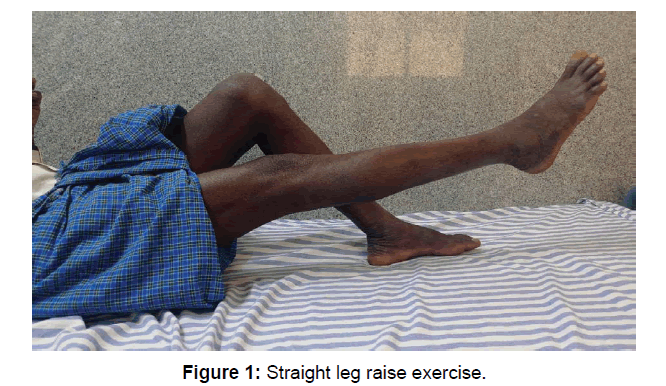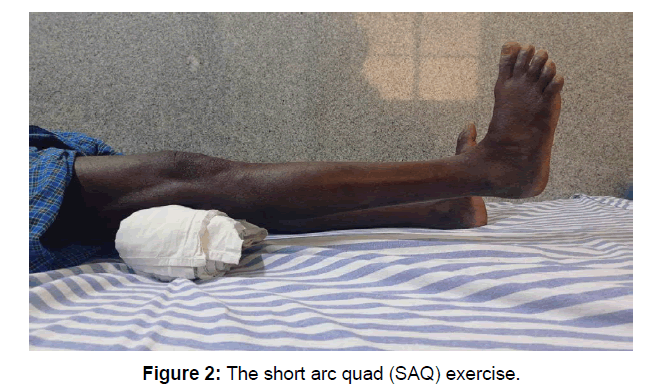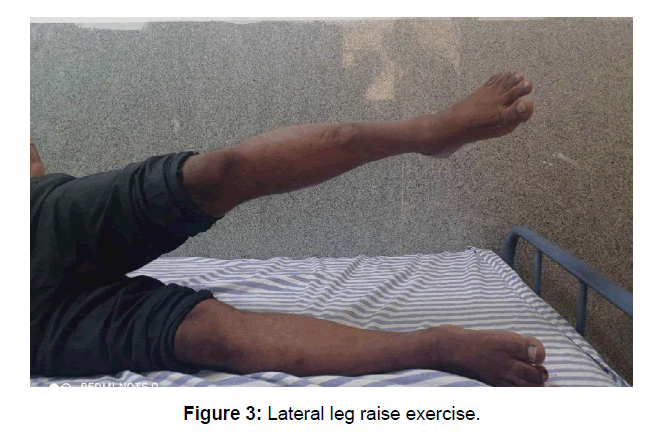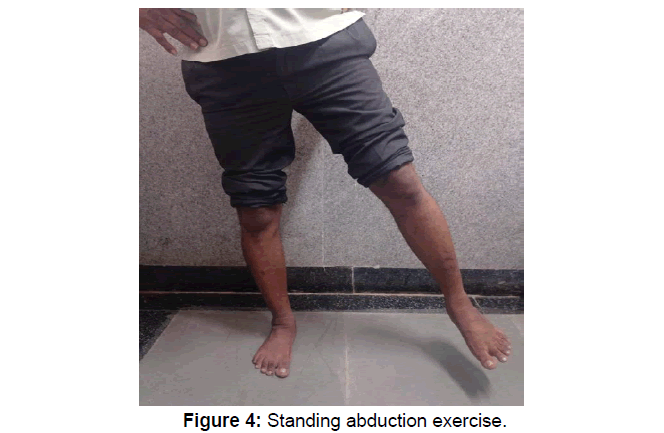A comparative study between quadriceps combined with hip abductor strengthening versus quadriceps strengthening in treating osteoarthritis of knee: A short term pilot study
DOI: 10.4172/2167-0846.1000367
Abstract
Background: Osteoarthritis is a chronic degenerative disease with predilection to elderly group. The efficacy of hip abductor strengthening is still controversial and hence not being routinely prescribed for treating patients with osteoarthritis knee. The current study aims at comparing quadriceps in combination with hip abductor strengthening can improve the function and reduce pain in KOA patients than quadriceps training alone.
Aims and Objective: To compare functional outcome and pain relief between patients receiving quadriceps and hip abductor strengthening with those undergoing quadriceps strengthening alone.
Materials and Method: 90 patients with symptomatic of osteoarthritis knee were randomly divided into two groups of 45 each. Cases in group 1 are managed with quadriceps strengthening exercises and group 2 with quadriceps combined with hip abductor strengthening exercises. Group 1 - straight leg raise and short arc quad (SAQ) exercises, group 2 in addition - lateral leg raise test and standing abduction test exercises were thought to the patient and were asked to continue for 6 weeks. Patients were evaluated at 6th, 8th, 10th week for VAS and WOMAC score.
Results: There significant difference in mean VAS and WOMAC score between two groups from 6th week to 10th week. Mean VAS score was high in group 1, mean WOMAC score was high in group 2
Conclusion: Quadriceps combined with hip abductor strengthening is a simple exercise that aims in relieving pain and improving functional outcome of knee. Incorporation of this in treating knee osteoarthritis patient yields a good functional outcome and cost effective.
Keywords: Osteoarthritis knee, Quadriceps strengthening exercises, Hip abductor strengthening exercises
Introduction
Inflammation of a joint characterized by pain, deformity and limitation of range of movements is known as Arthritis. Osteoarthritis is a chronic degenerative disease with predilection to elderly group and with advancing age its prevalence increases [1].
It a progressive disease resulting in degeneration of the articular cartilage of the joint and most commonly affecting the knee joint [2]. It is the fourth cause of disability in the world affecting the day-today activities, often reducing the quality of life and impairment of the patient’s independence [3].
Numerous treatment modalities are available for treating osteoarthritis knee which includes pharmacological management. Surgical management including proximal fibular osteotomy, total knee replacement surgery [4].
Non pharmacological management including life style modification, physiotherapy, ultrasonotherapy aims at reducing the pain, increasing the range of movement of the joint, thereby improving the quality of life [5].
Patient related factor such as age, attitude, comorbid conditions, economic status and compliance with treatment should be considered by a clinician while opting for a modality of treatment. Recent guidelines for osteoarthritis knee have paid attention to the non-pharmacological management [6].
Altered biomechanics of the knee joint and excessive joint loading has been recognized as important contributing factors for the disease progression of knee osteoarthritis [7]. Recent articles conclude that patients suffering from knee osteoarthritis have altered hip biomechanics in the form of weak hip abductor strength. Hip abductor strengthening can alleviate the symptoms and improve the knee functions of the osteoarthritis knee patients [8, 9].
Background
The efficacy of hip abductor strengthening is still controversial and hence not being routinely prescribed for treating patients with osteoarthritis knee. So, the current study was done to compare which among two groups of patients i.e., quadriceps combined with hip abductor strengthening versus quadriceps strengthening alone can result in reduction of pain and improved function in patients with osteoarthritis knee.
Aims and Objective
To compare functional outcome and pain relief between patients receiving quadriceps and hip abductor strengthening with those undergoing quadriceps strengthening alone.
Materials and Methods
1. A comparative pilot study, since it is pilot study no sample size will be calculated using any formula. All participants fitting into inclusion and exclusion criteria in study period duration will be enrolled in the study.
2. Sample size and duration – 2months (April – May 2020)
3. Mode of selection of subjects - This study will be conducted on patients attending the orthopedic outpatient section and inpatient of R.L. Jalappa hospital and research center Tamaka, Kolar. It is a prospective and comparative study of 90 cases of osteoarthritis knee. All subjects meeting inclusion and exclusion criteria included in the study. Patients were divided into two groups each group included 45 cases. Cases in group 1 are managed with quadriceps strengthening exercises and group 2 with quadriceps combined with hip abductor strengthening exercises. All the patients underwent x-ray knee of affected limb and then classified according to Kellgren Lawrence grading for osteoarthritis knee. Functional outcome was evaluated using WOMAC score and pain score using visual analogue scale (VAS) [10, 11].
Inclusion criteria
• Patients aged more than 45 years diagnosed with Kellgren- Lawrence grade (K-L grade) for osteoarthritis knee of grade II-IV.
• In case of bilateral OA knee, the more severely affected side was considered.
Exclusion criteria
• Patient aged > 80years
• Patients who underwent physiotherapy of hip and knee for past one month
• Patients with systemic arthritic conditions
• Patients who took systemic steroids within the last 1 month or intra-articular corticosteroid injection within the last 3 months
• Patients who had underwent hip or knee joint surgeries in the past
• Patient with lower limb neurological or muscular diseases
Methodology
Statistical analysis
Data was entered into Microsoft excel data sheet and was analyzed using SPSS 22 version software. Categorical data was represented in the form of Frequencies and proportions. Chi-square test was used as test of significance for qualitative data. Continuous data was represented as mean and standard deviation. Independent t test or Mann Whitney U test was used as test of significance to identify the mean difference between two quantitative variables and qualitative variables respectively [12, 13].
Graphical representation of data
MS Excel and MS word were used to obtain various types of graphs such as bar diagram.
p value (Probability that the result is true) of <0.05 was considered as statistically significant after assuming all the rules of statistical tests [14, 15]
Statistical software
MS Excel, SPSS version 22 (IBM SPSS Statistics, Somers NY, USA) was used to analyze data.
Procedure
All subjects included in the study received routine care management for osteoarthritis knee, including health education and pharmacological agent therapy (Tablet Paracetamol 650mg oral SOS) when necessary.
Group A: Quadriceps strengthening exercises Quadricepsstrengthening training was composed of two exercises designed to strengthen the quadriceps
1. Straight Leg Raise – patient made to lie on their back with the leg to be exercised in straight position. The other knee should be bent to support the lower back. Patient was asked to lift the diseased leg to the heel 25-30 cm away from the bed. It was held in that position for 5–10 seconds and then slowly laid down. As depicted in (Figure 1).
2. The short arc quad (SAQ) exercise -patient made to lie on their back and use a small paper towel roll to prop your knee up. Patient was asked to slowly straighten the bent knee until it is all the way straight. Tighten the quadriceps muscle and hold it tight for five seconds. Slowly lower leg down. As depicted in (Figure 2).
Group B: Quadriceps combined with hip abductor strengthening
It consists of group one exercises and two more hip abductor strengthening exercises which includes
1. Lateral leg raise exercise - Lying on the sound side bend the hip and knee to keep from rolling over. Raise the top leg towards the sky. Hold for 5 seconds, repeat in 3 sets of ten. The leg can be moved backwards as well to make the exercise harder. As depicted in (Figure 3).
2. Standing abduction exercise- Stand on the best leg. Turn the painful leg inward pointing across the body. Keeping the leg straight lift it out to the side and hold for 5 seconds. The pelvis should be kept level. A hand rail or table was be used for balance if needed. As depicted in (Figure 4).
All patients were asked to perform each exercise for 10 times as a set, for 3 sets each time and twice a day for 6 weeks altogether.
Results and Observations
In the present study, we evaluated the outcome of quadriceps versus quadriceps and hip abduction exercises by VAS score, Woman score. 90 patients with symptomatic of osteoarthritis knee were randomly divided into two groups of 45 each. Cases in group 1 are managed with quadriceps strengthening exercises and group 2 with quadriceps combined with hip abductor strengthening exercises.
In (Table 1), showing demographics comparison between two groups. Group A, mean age was 51.53 ± 6.15 years and in group B, mean age was 51.36 ± 6.85 years. In group A, 60% were females and 40% were males. In group B, 46.7% were females and 53.3% were males. In group A, 51.1% were on left side and 48.9% were on right side and in group B, 55.6% were on left side and 44.4% were in right side. In group A, Kellgren-Lawrence grade was 2 in 44.4%, grade 3 in 40% and grade 4 in 15.6% and in group B, Kellgren-Lawrence grade was 2 in 46.7%, grade 3 in 37.8% and grade 4 in 15.6%. There was no statistically significant difference in the above-mentioned parameters between two groups.
| DEMOGRAPHICS | GROUP A | GROUP B | p value |
|---|---|---|---|
| AGE in years | <50 years= 27 50-60 years= 14 >60 years= 4 |
<50 years= 32 50-60 years= 7 >60 years= 6 |
0.206 |
| SEX | M=18 F=27 |
M=21 F=24 |
0.205 |
| SIDE | RIGHT= 22 LEFT= 23 |
RIGHT= 20 LEFT= 25 |
0.673 |
| Kellgren-Lawrence grade | KL 2= 20 KL 3= 18 KL 4= 7 |
KL 2= 21 KL 3= 17 KL 4= 7 |
0.974 |
Table 1: Demographics comparison between two groups.
In (Table 2), VAS Score distribution comparison between two groups. There was significant difference in VAS Score between two groups at 4th week, 6th week, 8th week and 10th week. VAS Score was high in Quadriceps exercise group compared to Hip Abduction + Quadriceps exercise group. There was no significant difference in VAS score between two groups on Day 1 and 2nd week. Hip Abduction + Quadriceps exercise group had between reductions in VAS score compared to Quadriceps exercise group. In this study there was significant difference in mean VAS Score between two groups from 2nd week to 10th week. Mean VAS score was high in Quadriceps exercise group (group A) compared to Hip Abduction + Quadriceps exercise group (group B).
| VAS SCORE | DAY 1 | 2ND WEEK | 4TH WEEK | 6TH WEEK | 8TH WEEK | 10TH WEEK |
|---|---|---|---|---|---|---|
| Mean | Group A= 7.04 Group B= 6.93 |
Group A= 5.69 Group B= 5.00 |
Group A= 4.87 Group B= 3.91 |
Group A= 3.71 Group B= 3.02 |
Group A= 3.07 Group B= 2.49 |
Group A= 2.76 Group B= 2.16 |
| P value | 0.969 | 0.004 | <0.001 | <0.001 | 0.001 | <0.001 |
Table 2: VAS Score distribution comparison between two groups.
In (Table 3), WOMAC Score distribution comparison between two groups. There was no significant difference in WOMAC Score between two groups on Day 1. But there was significant difference in WOMAC Score between two groups at 6th Week and 10th Week. Mean WOMAC Score was high in Quadriceps exercise group (group A) compared to Hip Abduction + Quadriceps exercise group (group B).
| Group | P value | ||||||
|---|---|---|---|---|---|---|---|
| Group A- Quadriceps Exercise | Group B- Hip Abduction + Quadriceps exercise | ||||||
| Mean | SD | Median | Mean | SD | Median | ||
| Day 1 | 63.96 | 10.13 | 64 | 63.29 | 7.09 | 62 | 0.958 |
| 6th Week | 54.67 | 10.34 | 54 | 47.27 | 8.01 | 45 | <0.001* |
| 10th Week | 43.22 | 10.41 | 38 | 37.33 | 8.14 | 36 | 0.001* |
Table 3: WOMAC Score distribution comparison between two groups.
Discussion
Few studies showed that there is quadriceps muscle weakness compared to normal contralateral knee by 20-40 % in patients with osteoarthritis knee [16].
Hip musculature predominately hip abductor plays a role in stabilizing pelvis during a gait cycle. Weakness of hip abductors alter the biomechanics of the lower limb and increases the magnitude of knee adduction which a reason for osteoarthritis knee progression [17, 18]. Few articles has been published analyzing the strength of hip abductors in osteoarthritis knee. They have compared hip abductors strengthening versus quadriceps strengthening alone for treating osteoarthritis knee.
The mean age in our study of quadriceps exercise group was 51.53± 6.15 years and mean age of hip abduction + quadriceps exercise group was 51.36 ± 6.85 years and there was no statistically significant difference in sex, side, and Kellgren-Lawrence grade between two groups. Evaluation of VAS was done day 1 and every alternate week till 10th week. There was significant difference in VAS score between two groups from 4th week onwards till the final follow up. This implies that Hip Abduction + Quadriceps exercise group had better pain relief from osteoarthritis knee compared to Quadriceps exercise group. WOMAC score was evaluated on day1, 6th and 10th week. Mean WOMAC score was high in Quadriceps exercise group compared to Hip Abduction + Quadriceps exercise group. Low score signifies that patients had improvement in the stiffness and functional outcome of the limb evaluated through set of 24 questionnaires in WOMAC score.
Hinman et al [19] conducted a study to assess hip muscle weakness in medial compartment osteoarthritis knee patient with asymptomatic population group. With a hand held dynamometer isometric strength of hip flexors, abductors and adductors were measured. For assessing the knee pain VAS score was used and it was 4 ±2 over a week and in control group it was o which had significant p value. There was no significant difference in VAS score between two groups on Day 1 and by the end of 2nd week in our study. They had significant difference in p value because they compared with asymptomatic control group. Their study showed that there is hip musculature weakness present in osteoarthritis knee patient but was not proven whether it occurs as a consequence of the disease or it initiates the medial compartment osteoarthritis [19].
A study conducted by Yujie et all showed that there was relief in pain and improvement in knee range of movement when hip abductor strengthening regimen was added for physical therapy in treating osteoarthritis knee [19].They evaluated the functional outcome using VAC, WOMAC and short form health survey (SF-6).
Shreya et al in their study which included 4 parameters like 6 minute walk test, WOMAC score, hip strength and hip endurance for comparison between hip abductor strengthening versus quadriceps strengthening in patients with medial compartment osteoarthritis knee having a mean age of 55.10years. They used modified sphygmomanometer to measure hip abductor strength. Mean WOMAC score in hip strengthening group was 59 and in quadriceps group was 82 at the end of 6 weeks intervention, where as in our study mean WOMAC score was 47.27 in hip strengthening group and 54.67 quadriceps group at the end of 6th week of intervention which showed significant improvement in the functional outcome when compared to day one as well as compared to quadriceps strengthening group. They concluded that weakness of hip abductor acts a contributing factor for disease progression in osteoarthritis knee patients [20].
Costa and his colleagues conducted a study on assessment of isokinetic strength of hip muscles by comparing peak torque using isokinetic dynamometry in osteoarthritis knee patient and normal control group. Their study revealed there is significant lower peak torque in both ipsilateral and contralateral hip of osteoarthritis knee patient when compared to control group. They concluded that osteoarthritis knee patient exhibits lower isokinetic strength of hip muscles and reduced range of movement of knee when compared to control group who were free from symptoms [21].
Conclusion
A clinician has to consider the patients age, sex, family support, economic status while opting for the management for osteoarthritis. Adding Hip abductor exercise regimen along with quadriceps exercise helps in both, pain relief and improvement in functional outcome of the knee. There by it is a cost effective and simpler palliative treatment for prevention of disease progression in osteoarthritis knee patients.
References
- Zhang Y, Jordan JM. (2010). Epidemiology of osteoarthritis. Clinics in geriatric medicine; 26(3):355-69.
- Ringdal E, Pandit S. (2011). Treatment of knee osteoarthritis. AM Fam Physician; 83:1287-92
- Symmons D, Mathers C, Pfleger B. (2002). Global Burden of Osteoarthritis in Year 2000: Global Burden of Disease 2000 Study. Version 2. World Health Report: 5.
- Jevsevar DS. (2013). Treatment of osteoarthritis of the knee: evidence-based guideline. JAAOS-Journal of the American Academy of Orthopaedic Surgeons; 21(9):571-6.
- Fernandes L, Hagen KB, Bijlsma JW, Andreassen O, Christensen P. (2013). EULAR recommendations for the non-pharmacological core management of hip and knee osteoarthritis. Annals of the rheumatic diseases; 72(7):1125-35.
- Hochberg MC, Altman RD, April KT, Benkhalti M, Guyatt G. (2012). American College of Rheumatology recommendations for the use of nonpharmacologic and pharmacologic therapies in osteoarthritis of the hand, hip, and knee. Arthritis care & research; 64(4):465-74.
- Farrokhi S, Voycheck CA, Tashman S, Fitzgerald GK (2013) A biomechanical perspective on physical therapy management of knee osteoarthritis. J Orthop Sports PhysTher 43(9):600–619
- Costa RA, Oliveira LM, Watanabe SH, Jones A, Natour J. (2010). Isokinetic assessment of the hip muscles in patients with osteoarthritis of the knee. Clinics; 65(12):1253-9.
- Sled EA, Khoja L, Deluzio KJ, Olney SJ, Culham EG. (2010). Effect of a home program of hip abductor exercises on knee joint loading, strength, function, and pain in people with knee osteoarthritis: a clinical trial. Physical therapy; 90(6):895-904.
- McConnell S, Kolopack P, Davis AM. (2001). The Western Ontario and McMaster Universities Osteoarthritis Index (WOMAC): a review of its utility and measurement properties. Arthritis Care & Research: Official Journal of the American College of Rheumatology; 45(5):453-61.
- Boonstra AM, Preuper HR, Reneman MF, Posthumus JB, Stewart RE. (2008). Reliability and validity of the visual analogue scale for disability in patients with chronic musculoskeletal pain. International journal of rehabilitation research; 31(2):165-9.
- Gaddis ML, Gaddis GM. (1990). Introduction to biostatistics: Part 4, Statistical inference techniques in hypothesis testing. Ann Emerg Med; 19:820–825.
- Patra P. (2012). Sample size in clinical research, the number we need. Int J Med Sci Public Health; 1:5–9.
- Sunder Rao P S S, Richard J (2006). An Introduction to Biostatistics, A manual for students in health sciences, New Delhi: Prentice hall of India. 4th edition; 86-160.
- Elenbaas RM, Elenbaas JK, Cuddy PG. (1983). Evaluating the medical literature, part II: Statistical analysis .Ann Emerg Med; 12:610–620.
- Bennell KL, Hunt MA, Wrigley TV, Lim BW, Hinman RS. (2008). Role of muscle in the genesis and management of knee osteoarthritis. Rheumatic Disease Clinics of North America; 34(3):731-54.
- Xie Y, Zhang C, Jiang W, Huang J, Xu L. (2018). Quadriceps combined with hip abductor strengthening versus quadriceps strengthening in treating knee osteoarthritis: a study protocol for a randomized controlled trial. BMC musculoskeletal disorders; 19(1):147.
- Mündermann A, Dyrby CO, Andriacchi TP. (2005). Secondary gait changes in patients with medial compartment knee osteoarthritis: increased load at the ankle, knee, and hip during walking. Arthritis & Rheumatism; 52(9):2835-44.
- Hinman RS, Hunt MA, Creaby MW, Wrigley TV, McManus FJ. (2010). Hip muscle weakness in individuals with medial knee osteoarthritis. Arthritis care & research; 62(8):1190-3.
- Singh S, Pattnaik M, Mohanty P, Ganesh GS. (2016). Effectiveness of hip abductor strengthening on health status, strength, endurance and six minute walk test in participants with medial compartment symptomatic knee osteoarthritis. Journal of back and musculoskeletal rehabilitation; 29(1):65-75.
- Costa RA, Oliveira LM, Watanabe SH, Jones A, Natour J. (2010). Isokinetic assessment of the hip muscles in patients with osteoarthritis of the knee. Clinics; 65(12):1253-9.
Citation: Thagadur SC, Seenappa H, Shantappa AH, Anilkumar P (2021) A comparative study between quadriceps combined with hip abductor strengthening versus quadriceps strengthening in treating osteoarthritis of knee: A short term pilot study. J Pain Relief 10: 367. DOI: 10.4172/2167-0846.1000367
Copyright: © 2021 Thagadur SC, et al. This is an open-access article distributed under the terms of the Creative Commons Attribution License, which permits unrestricted use, distribution, and reproduction in any medium, provided the original author and source are credited.
Select your language of interest to view the total content in your interested language
Share This Article
Recommended Journals
Open Access Journals
Article Tools
Article Usage
- Total views: 2718
- [From(publication date): 0-2021 - Sep 23, 2025]
- Breakdown by view type
- HTML page views: 1867
- PDF downloads: 851




